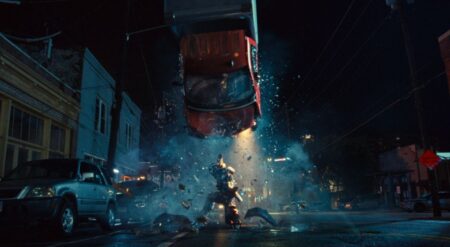Spoiler warning for various stories in the Dune franchise
Dune isn’t going anywhere anytime soon. The sci-fi franchise, shepherded by writer Frank Herbert, has persisted since the original 1965 novel’s publication. Since the release of director Denis Villeneuve’s Dune: Part One film adaptation, starring Timothée Chalamet and Zendaya, Dune has taken on a new cultural resonance. Now, Dune: Part Two has hit theaters to rave reviews and an impressive box office performance. This huge showing has many considering getting into the Dune universe, or the Duniverse, for the first time. The big question is: Where do I start in the Dune storyline?
Here at But Why Tho?, we want to give the reader the ultimate guide on how to get into Dune. Because the franchise extends into novels, comics, video games, and even board games and tabletop RPGs, it can be a bit intimidating. Worry not. Through this Beginner’s Guide to the “Duniverse,” we’ll attempt to make this journey as painless as possible.
The Dune Essentials

As simple as it sounds, the easiest way to start on one’s Dune journey is to read Dune. The 1965 novel by Frank Herbert is an utter classic. Following the journey of Paul Atreides as he goes from nervous adolescent to the de-facto messiah of the indigenous Fremen people of the planet Arrakis, or “Dune,” Dune will give readers the vital lore needed to navigate the rest of the series. The sandworms, the Great Houses, and Bene-Gesserit sisterhood are all introduced in the first go. Then, one can go straight to Dune Messiah.
A direct sequel by Herbert, Dune Messiah underlines the descent of Paul Atreides into fascistic anti-hero. Dune Messiah gives a proper ending to the story of Paul Atreides, while also building out the franchise’s world and laying the groundwork for the next novel. Released in 1976, Children of Dune passed the torch to Paul Atreides’ twin children, Leto II and Ghanima. Although delving into stranger territory than the previous two novels, Children of Dune is the true continuation. The novel’s conclusion sees Leto II Atreides becoming a beastly sandtrout-human hybrid. This leads to the book’s successor God Emperor of Dune. That novel, set 3500 years after the events of Children of Dune, marks the true ending of the Atreides storyline.
The Less Essentials (Dune Main Storyline Continued)

Despite the massive time jump, Frank Herbert chose to keep going with his Dune franchise. He continued into 1984 with Heretics of Dune, following that up directly with 1985’s Chapterhouse: Dune. While it must be noted that the series’ popularity wasn’t what it used to be, these novels still sold well. Heck, Frank Herbert even put a cliffhanger in Chapterhouse: Dune. Due to his untimely death in 1986, Herbert would never see the completion of his grand Dune storyline.
Nor would any reader until 2006 when Brian Herbert, Frank’s eldest son, and Kevin J. Anderson would elect to finish Frank Herbert’s story. Hunters of Dune released to a lukewarm reception. But due to being partially based on Frank Herbert’s notes for a proposed Dune 7, it’s the closest we can get to an official continuation. The rest of his notes were adapted into 2007’s Sandworms of Dune. None of the four novels in this section, particularly the latter two, are as canonized as the initial saga spanning from Dune to God Emperor of Dune. For fans, they’re still the best next steps for exploring the main thrust of the Dune story.
The Prequels/Interquels

Now we’re firmly in territory controlled by Brian Herbert and Kevin J. Anderson. In 1999, Herbert and Anderson told the stories of the Great Houses preceding the events of Dune. This manifested first in 1999’s Dune: House Atreides, then 2000’s Dune: House Harkonnen. They concluded with 2001’s Dune: House Corrino. That’s just about where one would stop if attempting to learn a little bit more about the Dune world not explored in the main saga. That’s far from where it ended, however. The Calladan trilogy, consisting of Dune: The Duke of Caladan, Dune: The Lady of Caladan, and Dune: The Heir of Caladan, filled in the gaps between House Corrino and Dune upon their releases between 2020-2022.
That’s not to mention the nearly unclassifiable Heroes of Dune sub-series. Initially intended to fill in the gaps between certain novels, Brian Herbert and Kevin J. Anderson released Paul of Dune in 2008. That novel is set in between Dune and Dune Messiah, while 2009’s The Winds of Dune bridges Dune Messiah and Children of Dune. The Heroes story seems more inconsequential than the larger narrative. The hird novel, Princess of Dune, set before Dune, came out with little fanfare as recently as 2023.
Believe it or not, there are even prequels to the prequels in the Dune storyline. The Legends of Dune series is there for those who want to explore much deeper into the far past era of the Buterlian Jihad. During the Butleriian Jihad, where all thinking machines (or computers) were eradicated. The Legends of Dune series comprises Dune: The Buterlian Jihad, Dune: The Machine Crusade, and Dune: The Battle of Corrin.
For those who want to know what happened in the furthest reaches of the timeline, this trilogy should do nicely. Moreover, Herbert and Anderson followed up this trilogy with another trilogy about the Bene-Gesserit and other competing factions leading up to the initial Dune. Entitled Great Schools of Dune, this trilogy includes Sisterhood of Dune, Mentats of Dune, and Navigators of Dune.
Other Print Materials

For those looking to satisfy their Dune fix in other print media, there are plenty of avenues to go down. Frank Herbert wrote a short story entitled “The Road to Dune” set in between Dune and Dune Messiah that’s published in his collection Eye. Plus, Brian Herbert and Kevin J. Anderson wrote eight additional short stories, collected in the 2017 Tales of Dune: Expanded Edition release. Beyond that, Herbert and Anderson wrote four novellas collected in the novel Sands of Dune.
There have also been a surprising number of Dune comic book adaptations, adding to the storyline. The first, based on David Lynch’s 1984 adaptation of the novel, by writer Ralph Macchio and artist Bill Siekiewicz, was released in several formats. More recently, a graphic novel adaptation of the novel itself was released in 2020 by Brian Herbert and Kevin J. Anderson. They also adapted their own novels Dune: House Atreides into a graphic novel and one of the short stories from The Sands of Dune, Dune: Blood of the Sardaukar, into their own one-shots as well.
The Games

In gaming, Dune has a long, but unremarkable, career. The first game was Cryo Interactive’s Dune in 1992. The sequel, Dune II, released in the same year from Westwood Studios. This release fared far better. In fact, it has been credited with being hugely influential for real-time strategy games going forward. This game received a remake in 1998, titled Dune 2000. The next release was a sequel to the remake, called Emperor: Battle For Dune. After that, Cryo and DreamCatcher Interactive worked on Frank Herbert’s Dune in 2001, based on the miniseries of the same name. Recently, Shiro Games and Funcom had the real-time strategy game Dune: Spice Wars, released in 2022.
The most recent announcement has been for Funcom’s Dune: Awakening. Not much is known about the project other than an initial trailer announcing it as an action MMO. The Dune franchise has also had a couple of board games, developed by Avalon Hill and Parker Brothers in 1979 and 1984, respectively. The newest board game is Dune: Imperium, released in 2019. <-make this two sentences In 1997, a collectible card game simply titled Dune came out. Two tabletop RPGs- 2000’s Dune: Chronicles of the Imperium and 2021’s Dune: Adventures in the Imperium, have also been released. The Dune games—virtual or physical—are intended to be supplements to the main experience, nothing more.
The Movies

If one wants to completely ignore experiencing the Dune franchise in print, there are some excellent ways to experience the story in visual formats. The first is director David Lynch’s 1984 adaptation simply titled Dune. Lynch was notoriously unhappy with the film and the film is noticeably obtuse to those who aren’t familiar with the novel. Nevertheless, the 1984 Dune continues to amass a cult following for its trippy visuals. At the very least, it’s worth it to see Kyle McLachlan (Twin Peaks) play Paul Atreides. Throw on the subtitles, lock in, and you could do worse for an introduction.
There have also been two TV miniseries. The first, Frank Herbert’s Dune released in 2000, adapting the first novel. Its sequel, 2003’s Frank Herbert’s Children of Dune, adapts Dune Messiah and Children of Dune. Despite their television budget, both are faithful, if a bit dry, ways to embark on the Dune journey.
The true visual media path to experiencing Dune is through Denis Villeneuve’s adaptations. Under the painterly eye of cinematographer Greig Fraser, helped by a script written by Villeneuve and Jon Spaihts, and a standout cast featuring everyone from Javier Bardem to Florence Pugh, these films work perfectly on their own. As translations of the novel, they are as close as one can possibly get, give or take a couple of key differences. Like the film adaptations of The Lord of the Rings, the modern Dune movies are a cultural behemoth in their own right.
There is no correct way to dive into the Dune storyline. It is an all-encompassing universe, tracking many storylines, locales, and characters spanning all different forms of media. Whether the intrigue comes from the giant sandworms, the tragic storyline of Paul Atreides’ descent into a tyrant, the Bene-Gesserit sisterhood, all the above, or none of the above, this guide should lay out many different entry points. The journey is yours to forge. Where will you start?
Dune: Part Two is now in theaters worldwide.







